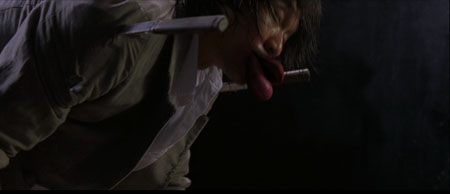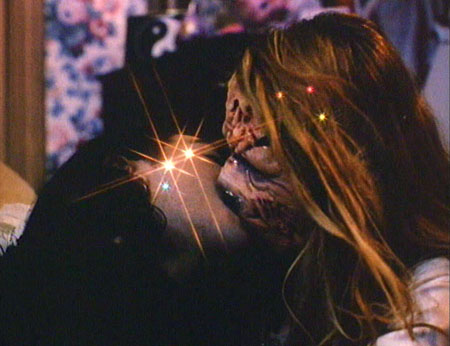DIRECTED BY: Jim Mallon
FEATURING: Mike Nelson, Trace Beaulieu, Kevin Murphy
PLOT: In this feature film from the cult TV show, a man and his two robot companions are trapped in space, forced by mad scientist Dr. Forrester to watch some of the worst movies of all time with only their own witty comments to distract them from the onslaught of ineptitude; in this experiment, they tackle the not-so-bad sci-fi film This Island Earth, in which aliens with bulging craniums kidnap Earth scientists in hopes of rescuing their home planet.

WHY IT WON’T MAKE THE LIST: “Mystery Science Theater 3000” (MST3K for short) was a fun, hip little cable TV show that ran from 1988 to 1999 wherein a man and his robots provided a humorous running commentary on old B-movies (many, like Horrors of Spider Island, of the so-bad-it’s-weird variety). Although the concept sounds strange, the smart and often very obscure pop-culture and other references that became the show’s comic staple made it more nerdy (in the complimentary sense) than weird in execution. Most of the movies featured were dull and incompetent rather than bizarre, and when they got their hands on something truly deranged (like The Wild World of Batwoman) the derision heaped on it by the commentators brought the absurdity to the surface and defused it. Not that this was a bad thing; it’s a devilishly funny exercise, if you’re tuned into the show’s arch sense of humor, but it’s not weird.
COMMENTS: Mystery Science Theater: The Movie is essentially “MST3K for Dummies.” It’s a nice lightweight litmus test for neophytes to see if they enjoy the style of humor on display and wish to penetrate deeper into the MST3K corpus (many original episodes are currently released on DVD; the double-disc The Essentials, featuring Manos: The Hands of Fate and Santa Claus Versus the Martians, is probably the best place to start). Distributors Gramercy Pictures were concerned that the “riffing” style of the TV show, which was filled with esoterica and in-jokes, might alienate newcomers to the series. Therefore, no references to Kierkegard, Bud Powell or “The Courtship of Eddie’s Father” make it into The Movie. For the most part, Mike, Crow and Tom confine their wisecracks to literal commentary about what’s onscreen: when a mutant hoves into frame, Mike astutely observes that he appears to be wearing slacks, while Tom and Crow quip that the matte painting depicting the alien landscape looks like the planet was designed either by Dr. Seuss or by someone painting a Yes album cover. The wisecracks come at the show’s typical breakneck pace, averaging perhaps three or four a minute, so there’s probably something here to tickle everyone’s funnybone. Still, the writers seem slightly out of their element in this outing: some of the bits seem too carefully scripted, and they grind out a couple of sex jokes and four letter words just to keep the film from getting a dreaded “G” rating. After test audiences unfamiliar with the show squirmed a bit at its length, the entire movie (“host sequences” and all) was cut to a mere 75 minutes at Gramercy’s insistence: by comparison, an average episode of the TV series averaged 90 minutes and the unedited (and more coherent) version of This Island Earth ran 86 minutes! [UPDATE 9/3/2013: Shout! Factory’s 2013 release includes the deleted scenes as extras, along with an alternate ending]..
A lot of the critical and fan debate at the time of release revolved around the selection of This Island Earth as the feature film to be mocked. This Island Earth was well-reviewed on its original release, and although the special effects are far from cutting edge today, many still consider it a minor gem. It’s neither one of the worst of all time nor any sort of real classic, but it isn’t half bad, a fact which the cast seems to acknowledge when the evil Dr. Forrester checks in at the end to see if the movie has broken Mike’s will and finds his unfazed guinea pig and the ‘bots throwing a “Metaluna mixer” instead. Despite it’s lack of acute badness (truly taxing schlock would have really alienated test audiences), the sci-fi potboiler was a reasonable choice for this particular venture. There’s a scientific naïveté to the film that lends itself to gentle mockery (“increase the Flash Gordon noise and put more science stuff around,” advises Crow at one point). More importantly, although the big-headed aliens, flying saucers and mutants with exposed brains look silly today, This Island Earth is still a beautiful looking Technicolor film, with its majestic, unreal pale-blue meteorite explosions and gleaming Space Age gizmos. Looking at the film today is like looking at well-crafted vintage comic book panels from the 1950s, and the visual inventiveness of the film provides a constantly pleasant backdrop to gaze at whenever neither the film’s plot nor the ‘bots quips are quite clicking. A few established critics seemed to accept the movie’s premise that This Island Earth was one of the worst films ever made. In the context of its time, it’s no worse than the brainless sci-fi thrills of Independence Day were to 1996 audiences, and it’s easily miles above Gramercy’s other big release of the year, the Pamela Anderson misfire Barb Wire. One wonders what the critics who thought This Island Earth was worthy of such derision would have made of some of the TV show’s more daring experiments in cinematic dreck, such as Monster a Go-Go or Manos?
WHAT THE CRITICS SAY:




